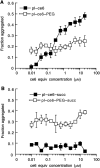Pegylation of charged polymer-photosensitiser conjugates: effects on photodynamic efficacy
- PMID: 12942129
- PMCID: PMC2394480
- DOI: 10.1038/sj.bjc.6601210
Pegylation of charged polymer-photosensitiser conjugates: effects on photodynamic efficacy
Abstract
Conjugates between photosensitisers (PS) and charged polymeric carriers are under investigation for photodynamic therapy of cancer and may allow targeting to certain cell types or compartments in tumours. Covalent attachment of polyethylene glycol to macromolecules (pegylation) may alter their pharmacokinetics, cell type targeting, and photophysical properties. Macrophages may take up large amounts of aggregated PS, thus lessening the selectivity for cancer cells in tumours. We investigated the effect of pegylation on the uptake and phototoxicity of poly-L-lysine chlorin(e6) conjugates with either cationic or anionic charges in two cell lines, human ovarian cancer cells and mouse macrophages. The cationic conjugate after pegylation became less aggregated, consumed less oxygen and had reduced cellular uptake. However, the phototoxicity corrected for cellular uptake increased three- to five-fold. In contrast, the anionic succinylated conjugate on pegylation became more aggregated, consumed similar amounts of oxygen, and had higher cellular uptake. The anionic conjugate showed the highest relative phototoxicity towards both the cell lines (compared to the other three conjugates) and it decreased most towards the macrophages after pegylation. Pegylation reduced the amount of oxygen consumed per chlorin(e6) molecule when photosensitised cells were illuminated. These in vitro studies suggest that pegylation alters the phototoxicity of PS conjugates depending on the effect produced on the aggregation state.
Figures



Similar articles
-
Pegylation of a chlorin(e6) polymer conjugate increases tumor targeting of photosensitizer.Cancer Res. 2001 Oct 1;61(19):7155-62. Cancer Res. 2001. PMID: 11585749
-
The effect of charge on cellular uptake and phototoxicity of polylysine chlorin(e6) conjugates.Photochem Photobiol. 1997 Apr;65(4):723-9. doi: 10.1111/j.1751-1097.1997.tb01916.x. Photochem Photobiol. 1997. PMID: 9114750
-
Syntheses and cellular investigations of di-aspartate and aspartate-lysine chlorin e(6) conjugates.Org Biomol Chem. 2016 Jan 21;14(3):1049-64. doi: 10.1039/c5ob02241j. Epub 2015 Dec 3. Org Biomol Chem. 2016. PMID: 26633562 Free PMC article.
-
Contrast-enhanced MRI-guided photodynamic cancer therapy with a pegylated bifunctional polymer conjugate.Pharm Res. 2008 Sep;25(9):2002-11. doi: 10.1007/s11095-008-9608-1. Epub 2008 Jun 27. Pharm Res. 2008. PMID: 18584312 Free PMC article.
-
Scavenger-receptor targeted photodynamic therapy.Photochem Photobiol. 2000 Oct;72(4):533-40. doi: 10.1562/0031-8655(2000)072<0533:srtpt>2.0.co;2. Photochem Photobiol. 2000. PMID: 11045726
Cited by
-
Antiviral peptide nanocomplexes as a potential therapeutic modality for HIV/HCV co-infection.Biomaterials. 2013 May;34(15):3846-57. doi: 10.1016/j.biomaterials.2013.01.026. Epub 2013 Feb 10. Biomaterials. 2013. PMID: 23403120 Free PMC article.
-
Syntheses and Photodynamic Activity of Pegylated Cationic Zn(II)-Phthalocyanines in HEp2 Cells.Theranostics. 2012;2(9):850-70. doi: 10.7150/thno.4547. Epub 2012 Sep 20. Theranostics. 2012. PMID: 23082098 Free PMC article.
-
In vitro optimization of EtNBS-PDT against hypoxic tumor environments with a tiered, high-content, 3D model optical screening platform.Mol Pharm. 2012 Nov 5;9(11):3171-82. doi: 10.1021/mp300262x. Epub 2012 Oct 11. Mol Pharm. 2012. PMID: 22946843 Free PMC article.
-
Protease-activated drug development.Theranostics. 2012;2(2):156-78. doi: 10.7150/thno.4068. Epub 2012 Feb 8. Theranostics. 2012. PMID: 22400063 Free PMC article.
-
Susceptibility of Cryptococcus neoformans to photodynamic inactivation is associated with cell wall integrity.Antimicrob Agents Chemother. 2007 Aug;51(8):2929-36. doi: 10.1128/AAC.00121-07. Epub 2007 Jun 4. Antimicrob Agents Chemother. 2007. PMID: 17548495 Free PMC article.
References
-
- Del Governatore M, Hamblin MR, Shea CR, Rizvi I, Molpus KG, Tanabe KK, Hasan T (2000b) Experimental photoimmunotherapy of hepatic metastases of colorectal cancer with a 17.1A chlorin(e6) immunoconjugate. Cancer Res 60: 4200–4205 - PubMed
-
- Delgado C, Francis GE, Fisher D (1992) The uses and properties of PEG-linked proteins. Crit Rev Ther Drug Carrier Syst 9: 249–304 - PubMed
Publication types
MeSH terms
Substances
Grants and funding
LinkOut - more resources
Full Text Sources

